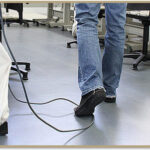DOS & DON’TS: [X] Don’t Ignore Hazards Identified by the JHSC

One of the key functions of the JHSC is to participate in inspections of the workplace designed to identify health and safety hazards before they result in an injury or other safety incident. But simply identifying hazards isn’t enough. It’s critical that you actually take steps to address any hazards the JHSC has identified, such as by installing machine guards to protect workers from pinch points and properly labelling containers of hazardous substances. Failing to address these hazards could result in injuries to workers and fines to employers.
That’s what happened to a hospital in Ontario. A nurse administered medication to a patient. When she left the patient’s bedside, she lost her balance and fell, breaking her arm. The cause: her foot had gotten caught in a cable attached to the bed check equipment in place on the patient’s bed. The cord hadn’t been properly secured, although hooks, clips or Velcro had been previously identified as methods of securing cords. In fact, dangling cords were a known safety hazard and had been documented in the JHSC’s inspection records. The MOL found that the hospital failed to provide adequate information, instruction and supervision with respect to avoiding trip hazards associated with cords. The hospital pleaded guilty and was fined $50,000 [St. Joseph’s Health Care London, Govt. News Release, June 5, 2014].
Insider Says: For more on the role of the JHSC in workplace safety’including workplace inspections’go to the JHSC Compliance Centre.